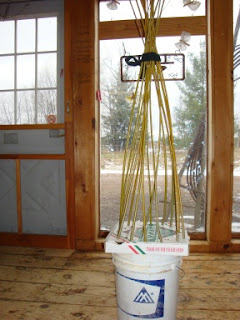 Despite the snow cover that greeted us yesterday morning, spring has come to northern Wisconsin. And while I still have some willow that needs to be cut, I've finished the harvest of my best stuff and done all the sorting I plan to do. It's time for the payoff -- weaving a few willow trellises for my gardens.
Despite the snow cover that greeted us yesterday morning, spring has come to northern Wisconsin. And while I still have some willow that needs to be cut, I've finished the harvest of my best stuff and done all the sorting I plan to do. It's time for the payoff -- weaving a few willow trellises for my gardens.My gardens are not showplaces, so I make whimsical trellises to distract from the general weediness and chaos in summer and bleakness in winter. Trellises also provide structure and support for plants. And because the rabbits and deer are bold as brass, I use willow trellises to make it harder for them to nibble.
Here's a peek at the process I use to make things like this Scarlett O'Trellis, photographed back when the roses were in bloom.
Raise The Stakes. Insert heavy willow rods into the holes in the pizza box and tie them loosely near the tips to keep them from flopping around until you get some weaving in place.
Wale On It. The willow used for weaving (or waling, in this case) needs to be smaller in diameter than the willow used in the stakes. For trellises, I use a slapdash version of 3 rod wale, a very strong triple-twining technique. And I break all kinds of rules that make darn good sense when you're making baskets. It's going into the garden. I probably won't take it up for winter. It's going to end up in the compost pile in a few years. And in the meantime, birds are going to decorate it with you-know-what. If it holds together well enough to suit me, it's fine.
Anyway, I weave several rows of 3 rod wale at the bottom. I add rods as needed, and (basketmakers are fainting here) don't up at the end of the row or do anything to make sure the weave is level. The birds won't care.
Up, Up And Away. When I have enough waling at the bottom that the rods stay where I want them, I start spiraling up. Since I've broken so many rules already, I stay with the program on the spiral. Where I add weavers, if it looks like a butt wants to stick out unattractively, I use a willow binder to make it behave.
Finish. Sometimes I put on a trac border, like in this compost catcher -- a bottomless basket that moves around the garden as needed so I can toss in stuff as I weed. Other times I just trim the stakes above the weaving and call it good. And sometimes I add elements to create figurative trellises.
Woven Components. To make woven components, I use some of the dry frames I made last year (read the Doodling With Willow post for more on those). I'll use the butt end of a piece of fresh willow as the center rib, then use the other end to lash it to the frame and start weaving. On the other end, I repeat the process, sticking the cut end of the butt into the weave on the opposite side. Here's the story in pictures.
Notice the long willow sticking out from that central rib? That's what I use to help lash the component into place. If I'm doing a figurative trellis, for example, that's the neck. If the component is really large, I might add some ribs. But since this isn't going to bear any weight, I'm pretty cavalier about the technique.
This is one of my Scarlett O'Trellises on a day last winter when it seemed that spring would never come. You can't really see all the construction details, so let me just simplify the idea with a couple of words: Whatever works.
Use the skills you have or whatever you can find in a book, and make up the rest. It doesn't have to be perfect, so don't worry about whether it's "right." On my first figurative trellis, I wasn't quite sure how to make the arms. So I made up something. Over time, the fresh willow dried and shrunk. That trellis was right outside the dining room window, and I loved watching those arms wobble in the wind and every time a bird perched there.
That trellis finally went on the compost pile last year. Those arms came off and she was neither a Scarlett O'Trellis nor a Venus d'Trellis. Now she's just a memory. And she still makes me smile.







Yep, there's no willow weaving police in Wisconsin. Just do as the lady says . . . whatever works works just fine!
ReplyDeleteloved when you gave this lecture/demo at AMB in '08. Always enjoy your lectures.
ReplyDeleteThank you both!
ReplyDelete